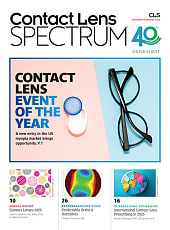FOCUS ON LOW VISION
10 Patient Tips
by Lynne W. Kinnan, MA
last month, we addressed practical things you can do to create a positive environment for your low vision patients. This month, I'd like to talk about attitude, and about how to continue that positive focus when it comes to presenting devices.
Here are 10 ways you can better help your patients.
THE RIGHT STUFF
1 Be honest. Don't view the world with rose-colored glasses. It is better to tell patients like it is so decisions can be made and there are realistic expectations.
2 Understand the challenge. You are probably the only person a visually impaired person feels safe talking to about issues and who understands the daily frustrations the patient is experiencing. Take the time to understand and listen to the patient.
3 Provide empathy. Don't provide sympathy, but do offer empathy. In other words, listen and understand what your patients are telling you, but don't take on their problems. Not only does it not help the situation but also it can create burnout for you and your staff.
4 Have patience. If you think it is difficult to have patience with your patients during their exam, just imagine how much patience it takes every day to deal with being visually impaired. Each patient needs to feel heard, valued, and safe coming in for an appointment.
5 Be proud. Take pride in knowing how much of an impact you have in improving a patient's life. Not just from the standpoint of being able to provide the best solutions with their daily struggle of being visually impaired. But also, there is finally someone that they can go to that has the ability to understand patients like no other health care professional they have consulted. It is a huge relief to finally have someone listen, understand, and work with them to find the best solutions.
6 Discuss daily activities. Understand the patients' daily activities so you know the best tools that create a more positive living experience for them. Pinpoint the things that are the most difficult or frustrating for them.
DISPENSING DEVICES
7 Make the most of what they have. Since there is a limited amount of resources that you have to work with in terms of the patients' eyesight, it is important to make the most of what they have.
A patient may be able to read one line better with new lenses. That may not seem significant to some, but when one has limited resources as in low vision cases, every little bit of improved vision can contribute to a better quality of life.
8 Be proactive. Research is constantly updating and modifying the options available to low vision patients. It is very important to stay informed of new products and procedures or options. Even though there may be items on the market that are not proven to create a positive change, provide options for the patient with an explanation of what your findings have been.
9 Provide choices. Discuss options for dealing with distance, reading, and reading a computer screen. If a patient could benefit from a telescopic lens, be sure to provide all of the options with regard to brands. When you find that a patient can read one line better with a new prescription, provide the option of changing lenses and let it be their choice.
10 Provide samples. Generally for a new patient, most of the information regarding available devices is their first exposure. They may not be familiar with tools such as a telescopic lens, an electronic reading machine, or a portable reading enhancer.
It is helpful to have a display of the different brand and types of the aforementioned products. A test drive may really help patients decide on an option—the patient can spend some time getting acclimated to the different tools and visual aids to determine which best fits their needs and their lifestyle. EB
For an educational tool that will benefit eyecare professionals, people with low vision, and their caregivers, check out "There's Hope for You," a video from the Vision Council of America's Low Vision Division. For more information or to order, contact 800-455-8006.
Patient Tips
[ patient resources ]
All too often, low vision patients are starved for information. There are a number of resources and organizations that can provide everything from referral services and networking opportunities to medical information.
One excellent patient-directed resource is a magazine produced by Eyecare Business for the Low Vision Division of the Vision Council of America earlier this year entitled "Eye on Low Vision." To order copies for your waiting room area, log onto lowvision@visionsite.org.
In addition to that publication, here are a variety of other excellent resources. We suggest you make a copy of this page and keep it on hand for patients who ask about outside resources.
ASSOCIATIONS/ORGANIZATIONS
■ AMD Alliance (http://http://www.amdalliance.org)
■ American Academy of Ophthalmology (http://http://www.aao.org)
■ American Academy of Optometry (http://http://www.aaopt.org)
■ American Council of the Blind (http://http://www.acb.org)
■ American Foundation for the Blind (http://http://www.afb.org)
■ American Optometric Association (http://http://www.aoa.org)
■ BiOptic Driving Network (http://http://www.biopticdriving.org)
■ Foundation Fighting Blindness (http://http://www.blindness.org)
■ Low Vision Division of the Vision Council of America (http://http://www.visionsite.org)
■ Macular Degeneration International (http://http://www.maculardegeneration.org)
■ Macular Degeneration Partnership (http://http://www.macd.net)
■ National Association for the Visually Handicapped (http://http://www.navh.org)
■ National Eye Institute (http://http://www.nei.nih.gov/)
ONLINE OPTIONS
■ http://www.Checkyearly.com/lowvision
■ http://www.HealthyVision2010.org
■ http://www.VisionConnection.org
RECORDINGS/LITERATURE
■ American Printing House for the Blind (http://http://www.aph.org)
■ Choice Magazine Listening (http://http://www.choicemagazinelistening.org)
■ EnVision and Aging Vision Newsletters (http://http://www.lighthouse.org)
■ Library of Congress Talking Book Program (http://http://www.loc.gov/nls)
■ New York Times Large Type Weekly (http://http://www.nytco.com)
■ Readers Digest Large Type Edition (http://http://www.readersdigest.com)
■ Recording for the Blind (http://http://www.rfbd.org)
By Stephanie K. De Long



